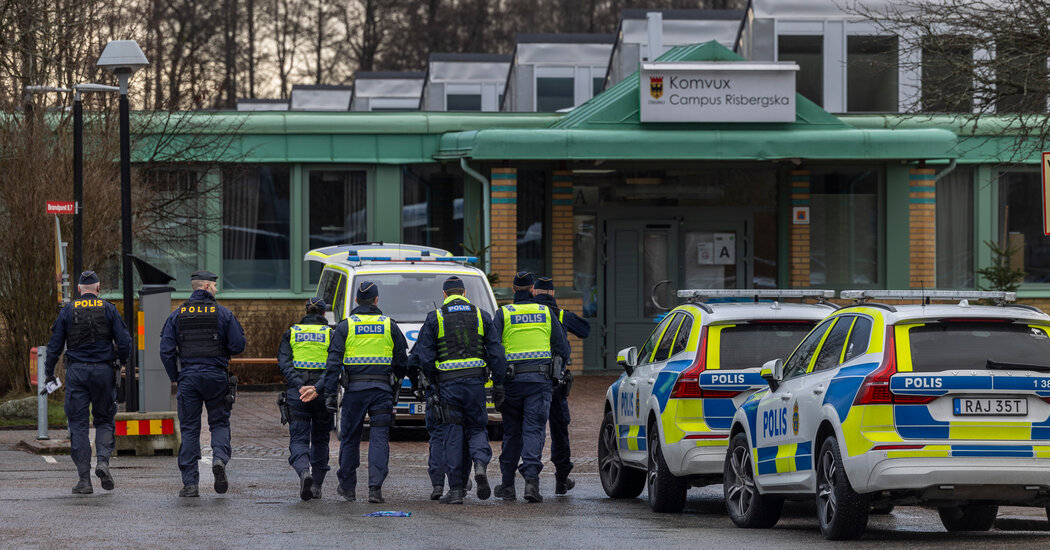The Swedish authorities said on Thursday that they were still seeking to determine why a man entered an adult education school this week and carried out an attack that the government called the worst mass shooting in the country’s history.
Swedish news outlets identified the shooter as Rickard Andersson, a 35-year-old who lived in Orebro, the city where the shooting occurred. The New York Times has not yet been able to independently confirm the shooter’s identity.
The police said that at least 11 people were found dead at the school, where many migrants enroll for Swedish language and other classes. The suspect is believed to be among the dead, the police said.
Here’s a look at what we know.
What happened?
Gunfire erupted at about 12:30 p.m. Tuesday at the Risbergska educational center, which offers classes to about 2,000 adults. Cellphone footage broadcast on local television showed students cowering under desks and chairs.
The authorities responded with a “major operation,” sending police cars and armed officers swarming onto the campus. Nearby schools were briefly put on lockdown.
The police charged into the school minutes after its alarm rang, Lars Wirén, the city’s police commander, said during a news conference on Thursday. They encountered a chaotic scene, with smoke from pyrotechnics filling the building, and a gunman firing so many rounds that officers could not tell how many shooters were on the scene, he added.
At least six adults were wounded in addition to those killed, according to the police. The authorities also said that six officers had been treated for smoke inhalation after responding to the scene.
Who is the suspect?
The police have not identified the shooter publicly, nor confirmed the name being widely reported. But they said they had identified the suspect among the deceased and were awaiting DNA confirmation.
The police said they believe that the shooter acted alone. Investigators traced four firearm licenses to the suspect. At the scene, police said they found the shooter with three weapons, including what appeared to be a rifle, and a large cache of ammunition.
Anna Bergqvist, an investigating officer, said at the news conference that the shooter had no prior convictions and was not previously known to the police.
She said they were reviewing videos taken during the shooting to see if they provided clues to the shooter’s motive.
Is gun ownership common in Sweden?
The attack sent shock waves through Sweden. Before Tuesday’s shooting, the country had experienced at least two school attacks in the last decade, but neither was carried out with a gun.
Sweden has long been known for low crime rates and high living standards, but statistics show that it has been grappling with one of the highest per capita rates of gun violence in the European Union.
Sweden has strict gun laws. Licenses require hefty application fees and are normally granted for hunters or members of sports shooting clubs, according to Sven Granath, a criminologist at Stockholm University.
“Legal guns, guns licensed to an owner, were seldom used in violent crimes in Sweden,” Mr. Granath said.
Still, gun violence has been on the rise, with a record of 391 instances in 2022, according to police figures. Mr. Granath said most of those crimes were linked to the drug trade and gangs, which control stockpiles of firearms smuggled in from postwar Balkan countries, Eastern Europe and Turkey. However, he said what happened on Tuesday was different.
The shooting in Orebro, he said, appeared to more closely resemble school shootings in the United States because the police said it appeared that the perpetrator had acted alone.
How is Sweden responding?
Families of the dead and wounded gathered on Wednesday outside the educational center in Orebro, which remained shuttered and cordoned off with blue and white police tape. Police officers stood guard around the yellow-brick building as people placed flowers and candles outside the center.
Prime Minister Ulf Kristersson, who had ordered flags to be flown at half-staff in response to what he called a “horrific act of violence,” visited the makeshift memorial. King Carl XVI Gustaf of Sweden and Queen Silvia, his wife, also went there to lay flowers.
“We are very shocked,” the king said, according to Agence France-Presse.
Peter Larsson, the municipal director of Orebro, said the educational center would remain closed for at least the rest of the week.
“I’m devastated,” Mr. Larsson said.

